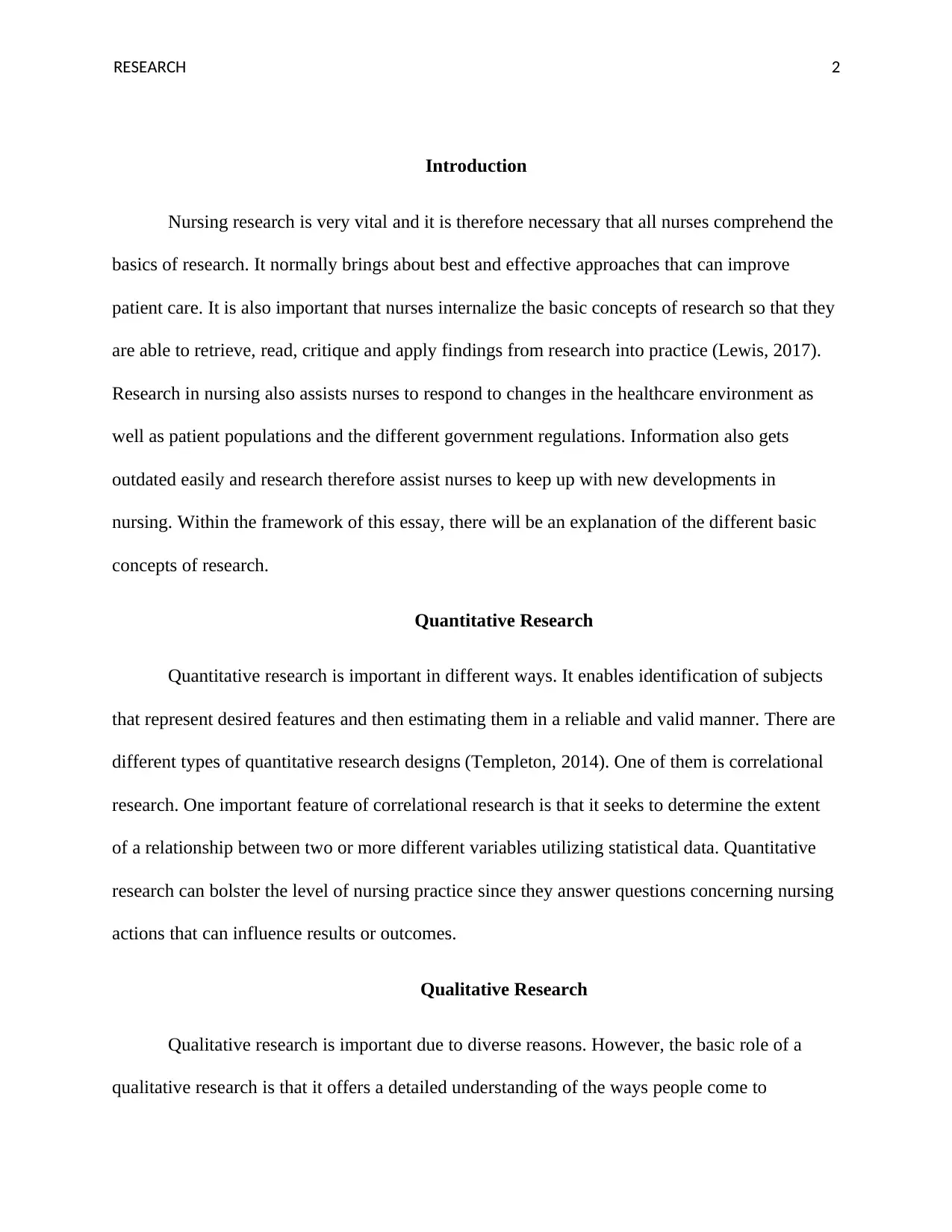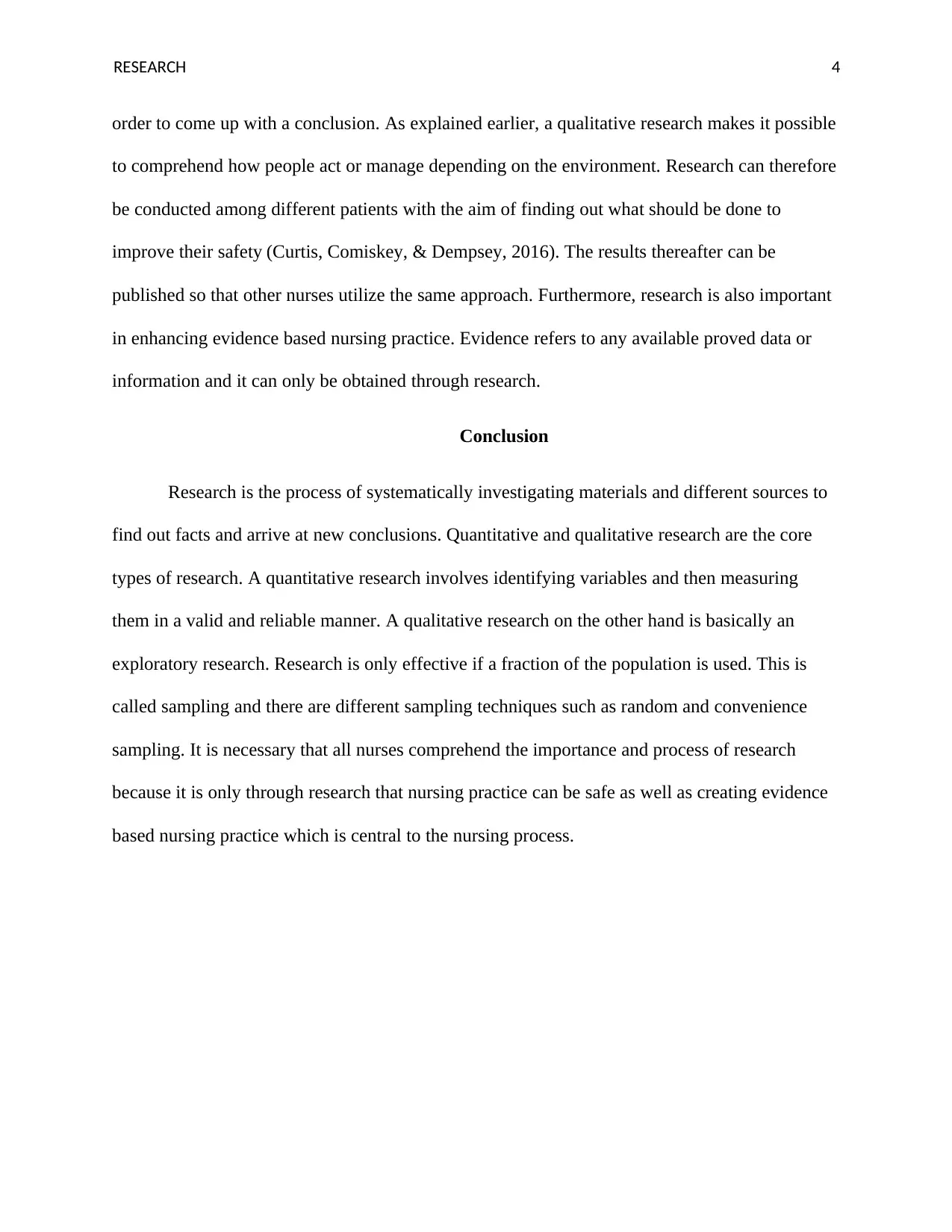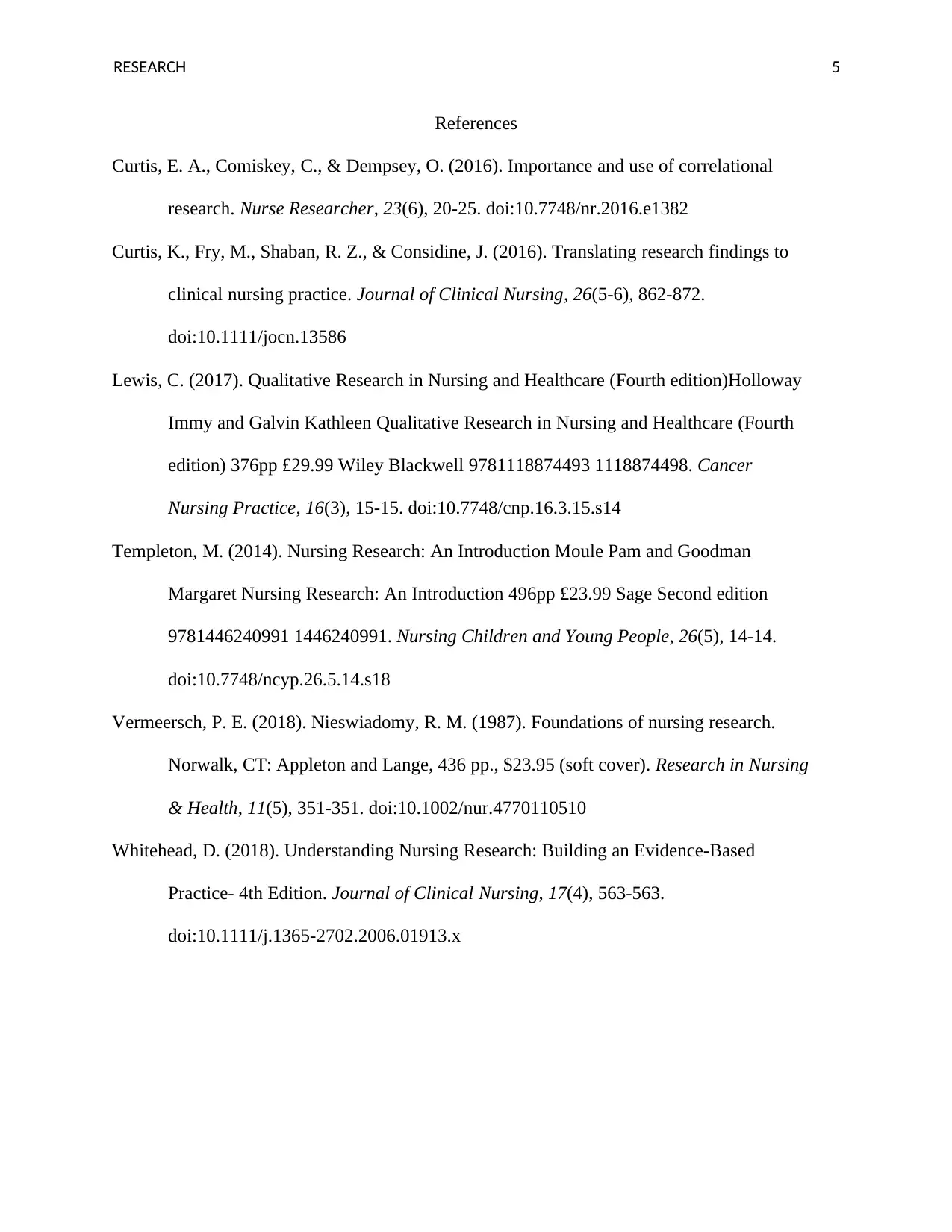NR439 Research Designs: Improving Nursing with Research Methods
VerifiedAdded on 2023/03/30
|5
|928
|378
Report
AI Summary
This report provides an overview of basic research concepts in nursing, emphasizing the importance of both quantitative and qualitative research methods. Quantitative research is defined by its focus on identifying and measuring variables, with correlational research highlighted as a key design. Qualitative research, on the other hand, offers in-depth understanding of people's actions and experiences, exemplified by the case study model. The report also addresses research sampling, explaining its necessity for managing large populations and different techniques like random and convenience sampling. The importance of research in ensuring safety in nursing practice and enhancing evidence-based nursing is underscored, concluding that a strong grasp of research principles is essential for all nurses to improve patient care and adapt to healthcare advancements. Desklib provides a platform for students to access this and other solved assignments.

Running head: RESEARCH 1
Research
Name:
Institution:
Tutor:
Date:
Research
Name:
Institution:
Tutor:
Date:
Paraphrase This Document
Need a fresh take? Get an instant paraphrase of this document with our AI Paraphraser

RESEARCH 2
Introduction
Nursing research is very vital and it is therefore necessary that all nurses comprehend the
basics of research. It normally brings about best and effective approaches that can improve
patient care. It is also important that nurses internalize the basic concepts of research so that they
are able to retrieve, read, critique and apply findings from research into practice (Lewis, 2017).
Research in nursing also assists nurses to respond to changes in the healthcare environment as
well as patient populations and the different government regulations. Information also gets
outdated easily and research therefore assist nurses to keep up with new developments in
nursing. Within the framework of this essay, there will be an explanation of the different basic
concepts of research.
Quantitative Research
Quantitative research is important in different ways. It enables identification of subjects
that represent desired features and then estimating them in a reliable and valid manner. There are
different types of quantitative research designs (Templeton, 2014). One of them is correlational
research. One important feature of correlational research is that it seeks to determine the extent
of a relationship between two or more different variables utilizing statistical data. Quantitative
research can bolster the level of nursing practice since they answer questions concerning nursing
actions that can influence results or outcomes.
Qualitative Research
Qualitative research is important due to diverse reasons. However, the basic role of a
qualitative research is that it offers a detailed understanding of the ways people come to
Introduction
Nursing research is very vital and it is therefore necessary that all nurses comprehend the
basics of research. It normally brings about best and effective approaches that can improve
patient care. It is also important that nurses internalize the basic concepts of research so that they
are able to retrieve, read, critique and apply findings from research into practice (Lewis, 2017).
Research in nursing also assists nurses to respond to changes in the healthcare environment as
well as patient populations and the different government regulations. Information also gets
outdated easily and research therefore assist nurses to keep up with new developments in
nursing. Within the framework of this essay, there will be an explanation of the different basic
concepts of research.
Quantitative Research
Quantitative research is important in different ways. It enables identification of subjects
that represent desired features and then estimating them in a reliable and valid manner. There are
different types of quantitative research designs (Templeton, 2014). One of them is correlational
research. One important feature of correlational research is that it seeks to determine the extent
of a relationship between two or more different variables utilizing statistical data. Quantitative
research can bolster the level of nursing practice since they answer questions concerning nursing
actions that can influence results or outcomes.
Qualitative Research
Qualitative research is important due to diverse reasons. However, the basic role of a
qualitative research is that it offers a detailed understanding of the ways people come to

RESEARCH 3
comprehend, act and then manage their daily situations depending on the settings. An example of
qualitative research design is case study model (Vermeersch, 2018). This method involves an
analysis of one test subject though data is collected from different sources to make a final
conclusion. Qualitative research can really bolster the level of nursing practice by assisting to
comprehend and implement the best interventions since they address questions regarding
patient’s experiences.
Research Sampling
Researchers work with a sample which is basically a group of people that can be taken to
represent the larger population for measurement. Sampling is now the process of selecting the
desired characters for research. In study, sampling is very important for different reasons. First of
all, it is not possible to conduct research on a high population like a whole country. This would
take so much time and resources (Whitehead, 2008, p. 2018). Sampling therefore simplifies the
process of research and facilitates collection and analysis of data. However, it is important that
the samples selected represent the face of the entire population. Sampling techniques are also
diverse depending on whether it is a qualitative or quantitative research. Random sampling is an
example of sampling in quantitative studies (Curtis, Fry, Shaban, & Considine, 2016). In this
type of sampling, all subjects within the population have an equal opportunity of being chosen
for research. Another sampling technique that I have learnt is the convenience sampling and this
involves the researcher using subjects that are convenient to him/her.
Credible Nursing Practice
Research is the appropriate tool that can be utlised to ensure safety in nursing. According
to different studies, research involves systematic collection of data and then analyze the data in
comprehend, act and then manage their daily situations depending on the settings. An example of
qualitative research design is case study model (Vermeersch, 2018). This method involves an
analysis of one test subject though data is collected from different sources to make a final
conclusion. Qualitative research can really bolster the level of nursing practice by assisting to
comprehend and implement the best interventions since they address questions regarding
patient’s experiences.
Research Sampling
Researchers work with a sample which is basically a group of people that can be taken to
represent the larger population for measurement. Sampling is now the process of selecting the
desired characters for research. In study, sampling is very important for different reasons. First of
all, it is not possible to conduct research on a high population like a whole country. This would
take so much time and resources (Whitehead, 2008, p. 2018). Sampling therefore simplifies the
process of research and facilitates collection and analysis of data. However, it is important that
the samples selected represent the face of the entire population. Sampling techniques are also
diverse depending on whether it is a qualitative or quantitative research. Random sampling is an
example of sampling in quantitative studies (Curtis, Fry, Shaban, & Considine, 2016). In this
type of sampling, all subjects within the population have an equal opportunity of being chosen
for research. Another sampling technique that I have learnt is the convenience sampling and this
involves the researcher using subjects that are convenient to him/her.
Credible Nursing Practice
Research is the appropriate tool that can be utlised to ensure safety in nursing. According
to different studies, research involves systematic collection of data and then analyze the data in
⊘ This is a preview!⊘
Do you want full access?
Subscribe today to unlock all pages.

Trusted by 1+ million students worldwide

RESEARCH 4
order to come up with a conclusion. As explained earlier, a qualitative research makes it possible
to comprehend how people act or manage depending on the environment. Research can therefore
be conducted among different patients with the aim of finding out what should be done to
improve their safety (Curtis, Comiskey, & Dempsey, 2016). The results thereafter can be
published so that other nurses utilize the same approach. Furthermore, research is also important
in enhancing evidence based nursing practice. Evidence refers to any available proved data or
information and it can only be obtained through research.
Conclusion
Research is the process of systematically investigating materials and different sources to
find out facts and arrive at new conclusions. Quantitative and qualitative research are the core
types of research. A quantitative research involves identifying variables and then measuring
them in a valid and reliable manner. A qualitative research on the other hand is basically an
exploratory research. Research is only effective if a fraction of the population is used. This is
called sampling and there are different sampling techniques such as random and convenience
sampling. It is necessary that all nurses comprehend the importance and process of research
because it is only through research that nursing practice can be safe as well as creating evidence
based nursing practice which is central to the nursing process.
order to come up with a conclusion. As explained earlier, a qualitative research makes it possible
to comprehend how people act or manage depending on the environment. Research can therefore
be conducted among different patients with the aim of finding out what should be done to
improve their safety (Curtis, Comiskey, & Dempsey, 2016). The results thereafter can be
published so that other nurses utilize the same approach. Furthermore, research is also important
in enhancing evidence based nursing practice. Evidence refers to any available proved data or
information and it can only be obtained through research.
Conclusion
Research is the process of systematically investigating materials and different sources to
find out facts and arrive at new conclusions. Quantitative and qualitative research are the core
types of research. A quantitative research involves identifying variables and then measuring
them in a valid and reliable manner. A qualitative research on the other hand is basically an
exploratory research. Research is only effective if a fraction of the population is used. This is
called sampling and there are different sampling techniques such as random and convenience
sampling. It is necessary that all nurses comprehend the importance and process of research
because it is only through research that nursing practice can be safe as well as creating evidence
based nursing practice which is central to the nursing process.
Paraphrase This Document
Need a fresh take? Get an instant paraphrase of this document with our AI Paraphraser

RESEARCH 5
References
Curtis, E. A., Comiskey, C., & Dempsey, O. (2016). Importance and use of correlational
research. Nurse Researcher, 23(6), 20-25. doi:10.7748/nr.2016.e1382
Curtis, K., Fry, M., Shaban, R. Z., & Considine, J. (2016). Translating research findings to
clinical nursing practice. Journal of Clinical Nursing, 26(5-6), 862-872.
doi:10.1111/jocn.13586
Lewis, C. (2017). Qualitative Research in Nursing and Healthcare (Fourth edition)Holloway
Immy and Galvin Kathleen Qualitative Research in Nursing and Healthcare (Fourth
edition) 376pp £29.99 Wiley Blackwell 9781118874493 1118874498. Cancer
Nursing Practice, 16(3), 15-15. doi:10.7748/cnp.16.3.15.s14
Templeton, M. (2014). Nursing Research: An Introduction Moule Pam and Goodman
Margaret Nursing Research: An Introduction 496pp £23.99 Sage Second edition
9781446240991 1446240991. Nursing Children and Young People, 26(5), 14-14.
doi:10.7748/ncyp.26.5.14.s18
Vermeersch, P. E. (2018). Nieswiadomy, R. M. (1987). Foundations of nursing research.
Norwalk, CT: Appleton and Lange, 436 pp., $23.95 (soft cover). Research in Nursing
& Health, 11(5), 351-351. doi:10.1002/nur.4770110510
Whitehead, D. (2018). Understanding Nursing Research: Building an Evidence-Based
Practice- 4th Edition. Journal of Clinical Nursing, 17(4), 563-563.
doi:10.1111/j.1365-2702.2006.01913.x
References
Curtis, E. A., Comiskey, C., & Dempsey, O. (2016). Importance and use of correlational
research. Nurse Researcher, 23(6), 20-25. doi:10.7748/nr.2016.e1382
Curtis, K., Fry, M., Shaban, R. Z., & Considine, J. (2016). Translating research findings to
clinical nursing practice. Journal of Clinical Nursing, 26(5-6), 862-872.
doi:10.1111/jocn.13586
Lewis, C. (2017). Qualitative Research in Nursing and Healthcare (Fourth edition)Holloway
Immy and Galvin Kathleen Qualitative Research in Nursing and Healthcare (Fourth
edition) 376pp £29.99 Wiley Blackwell 9781118874493 1118874498. Cancer
Nursing Practice, 16(3), 15-15. doi:10.7748/cnp.16.3.15.s14
Templeton, M. (2014). Nursing Research: An Introduction Moule Pam and Goodman
Margaret Nursing Research: An Introduction 496pp £23.99 Sage Second edition
9781446240991 1446240991. Nursing Children and Young People, 26(5), 14-14.
doi:10.7748/ncyp.26.5.14.s18
Vermeersch, P. E. (2018). Nieswiadomy, R. M. (1987). Foundations of nursing research.
Norwalk, CT: Appleton and Lange, 436 pp., $23.95 (soft cover). Research in Nursing
& Health, 11(5), 351-351. doi:10.1002/nur.4770110510
Whitehead, D. (2018). Understanding Nursing Research: Building an Evidence-Based
Practice- 4th Edition. Journal of Clinical Nursing, 17(4), 563-563.
doi:10.1111/j.1365-2702.2006.01913.x
1 out of 5
Related Documents
Your All-in-One AI-Powered Toolkit for Academic Success.
+13062052269
info@desklib.com
Available 24*7 on WhatsApp / Email
![[object Object]](/_next/static/media/star-bottom.7253800d.svg)
Unlock your academic potential
Copyright © 2020–2025 A2Z Services. All Rights Reserved. Developed and managed by ZUCOL.




